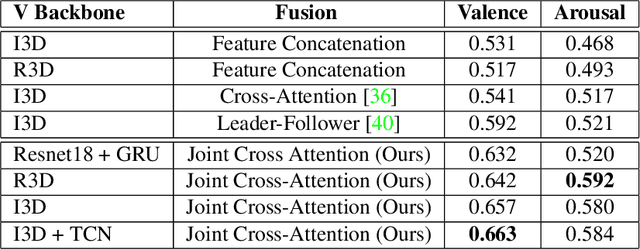Osama Zeeshan
Joint Multimodal Transformer for Dimensional Emotional Recognition in the Wild
Mar 15, 2024Abstract:Audiovisual emotion recognition (ER) in videos has immense potential over unimodal performance. It effectively leverages the inter- and intra-modal dependencies between visual and auditory modalities. This work proposes a novel audio-visual emotion recognition system utilizing a joint multimodal transformer architecture with key-based cross-attention. This framework aims to exploit the complementary nature of audio and visual cues (facial expressions and vocal patterns) in videos, leading to superior performance compared to solely relying on a single modality. The proposed model leverages separate backbones for capturing intra-modal temporal dependencies within each modality (audio and visual). Subsequently, a joint multimodal transformer architecture integrates the individual modality embeddings, enabling the model to effectively capture inter-modal (between audio and visual) and intra-modal (within each modality) relationships. Extensive evaluations on the challenging Affwild2 dataset demonstrate that the proposed model significantly outperforms baseline and state-of-the-art methods in ER tasks.
A Joint Cross-Attention Model for Audio-Visual Fusion in Dimensional Emotion Recognition
Apr 04, 2022



Abstract:Multimodal emotion recognition has recently gained much attention since it can leverage diverse and complementary relationships over multiple modalities (e.g., audio, visual, biosignals, etc.), and can provide some robustness to noisy modalities. Most state-of-the-art methods for audio-visual (A-V) fusion rely on recurrent networks or conventional attention mechanisms that do not effectively leverage the complementary nature of A-V modalities. In this paper, we focus on dimensional emotion recognition based on the fusion of facial and vocal modalities extracted from videos. Specifically, we propose a joint cross-attention model that relies on the complementary relationships to extract the salient features across A-V modalities, allowing for accurate prediction of continuous values of valence and arousal. The proposed fusion model efficiently leverages the inter-modal relationships, while reducing the heterogeneity between the features. In particular, it computes the cross-attention weights based on correlation between the combined feature representation and individual modalities. By deploying the combined A-V feature representation into the cross-attention module, the performance of our fusion module improves significantly over the vanilla cross-attention module. Experimental results on validation-set videos from the AffWild2 dataset indicate that our proposed A-V fusion model provides a cost-effective solution that can outperform state-of-the-art approaches. The code is available on GitHub: https://github.com/praveena2j/JointCrossAttentional-AV-Fusion.
 Add to Chrome
Add to Chrome Add to Firefox
Add to Firefox Add to Edge
Add to Edge